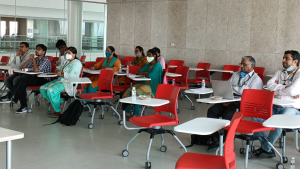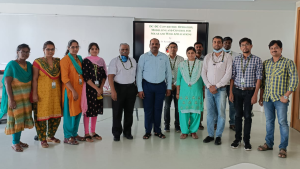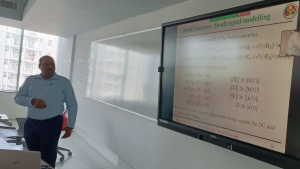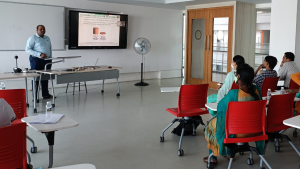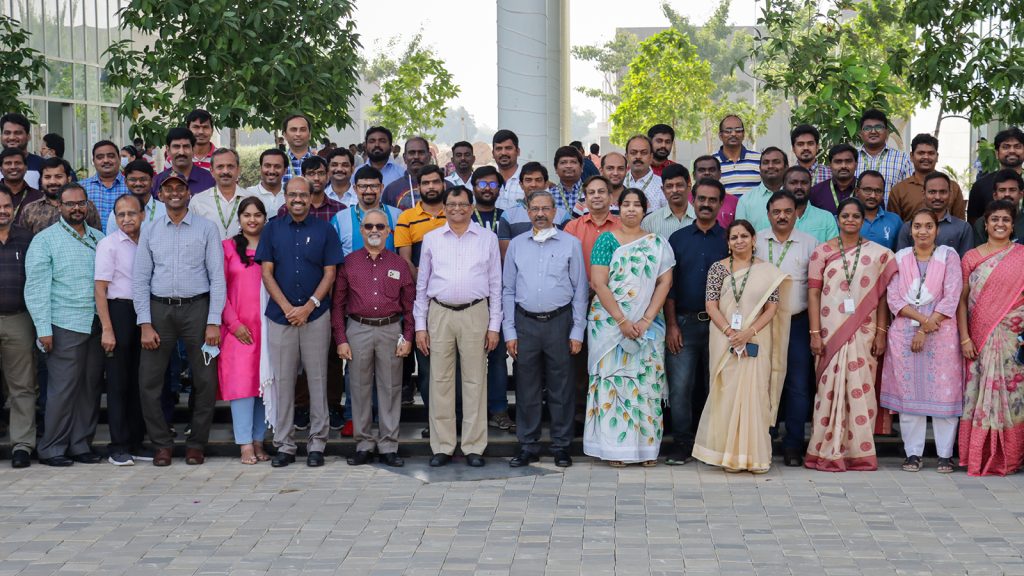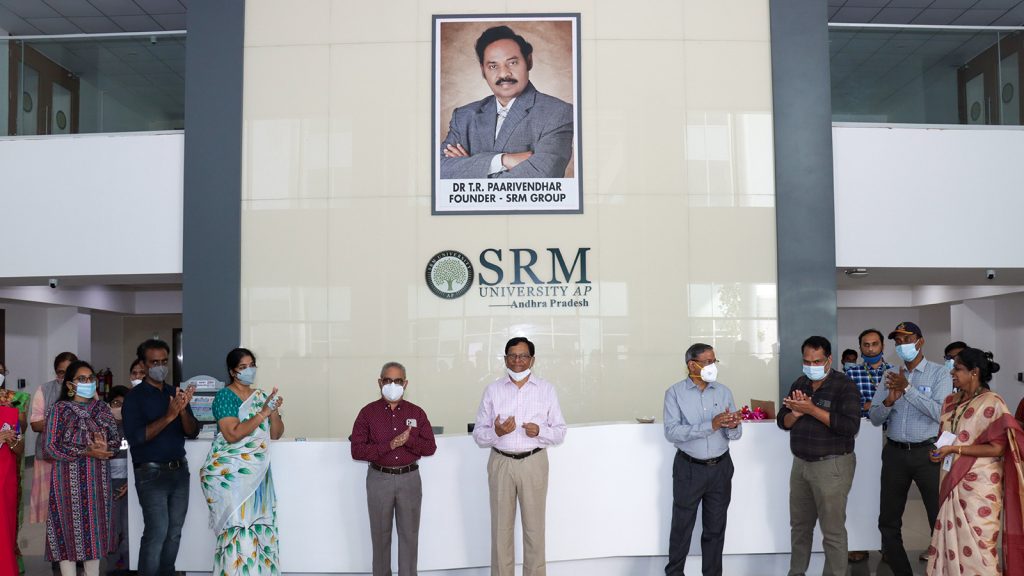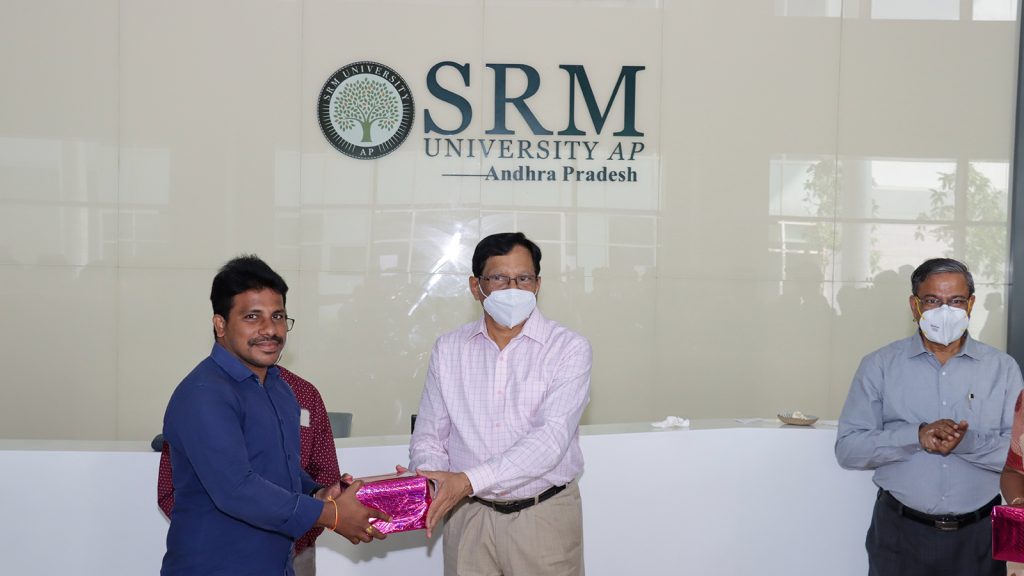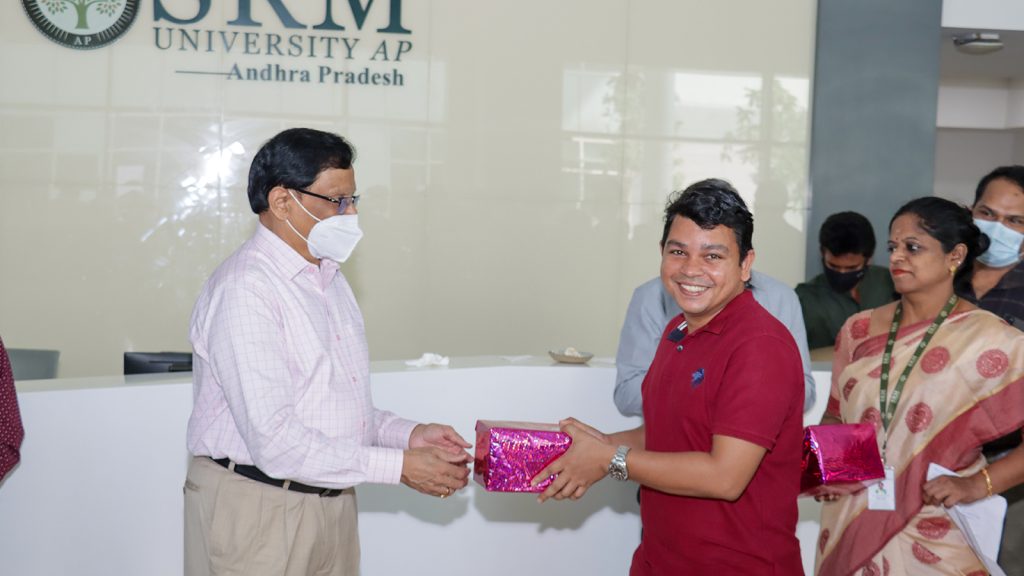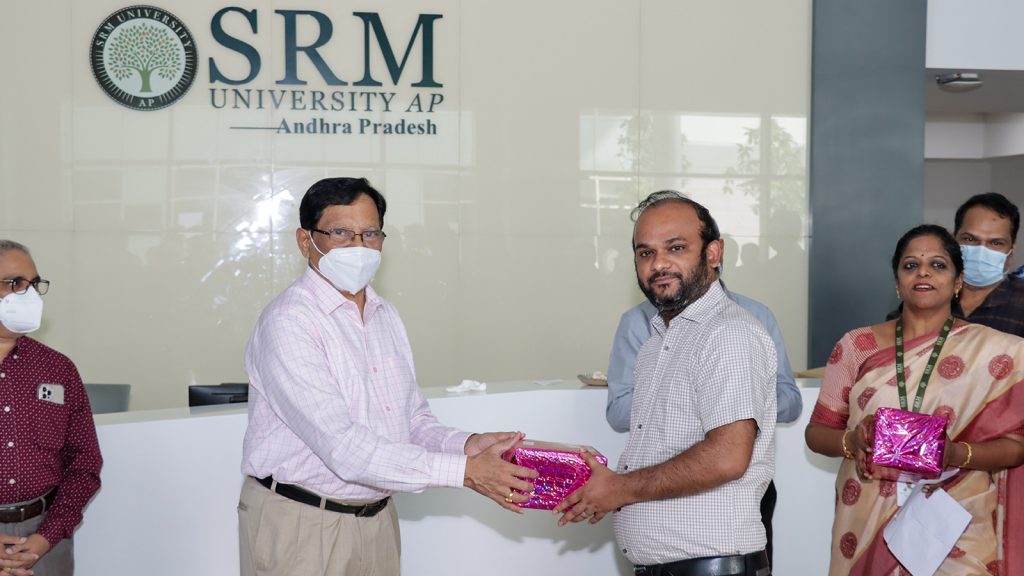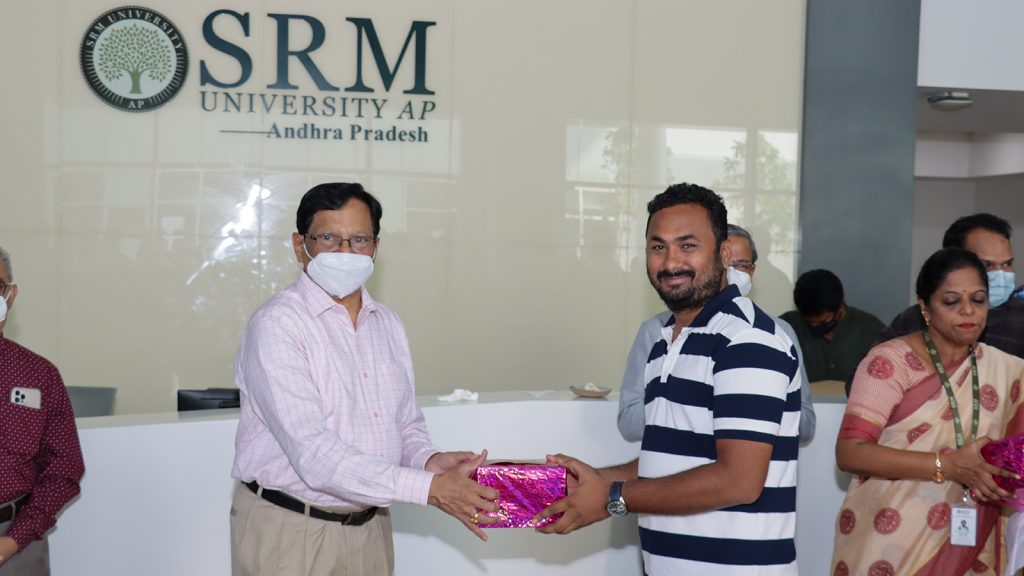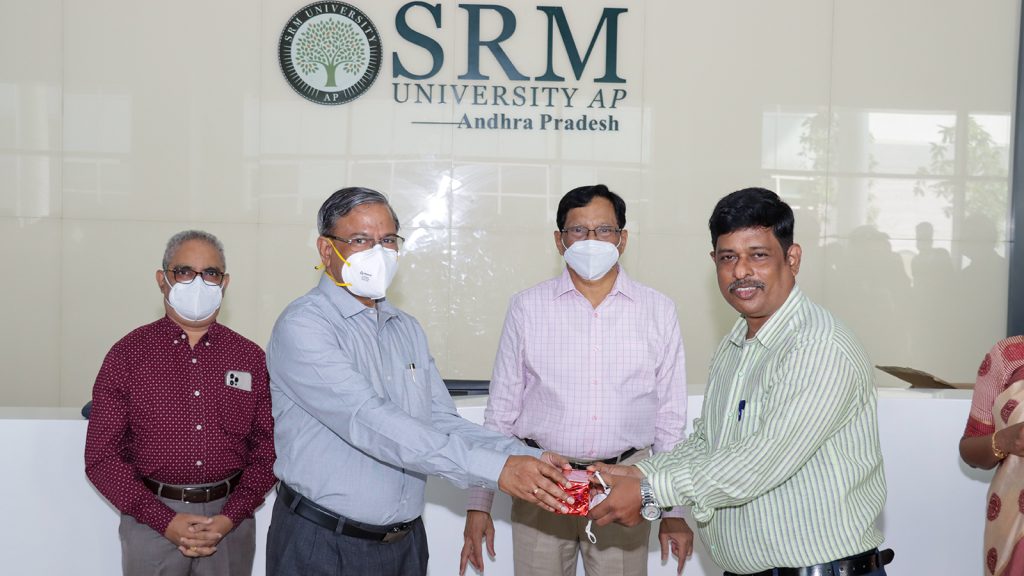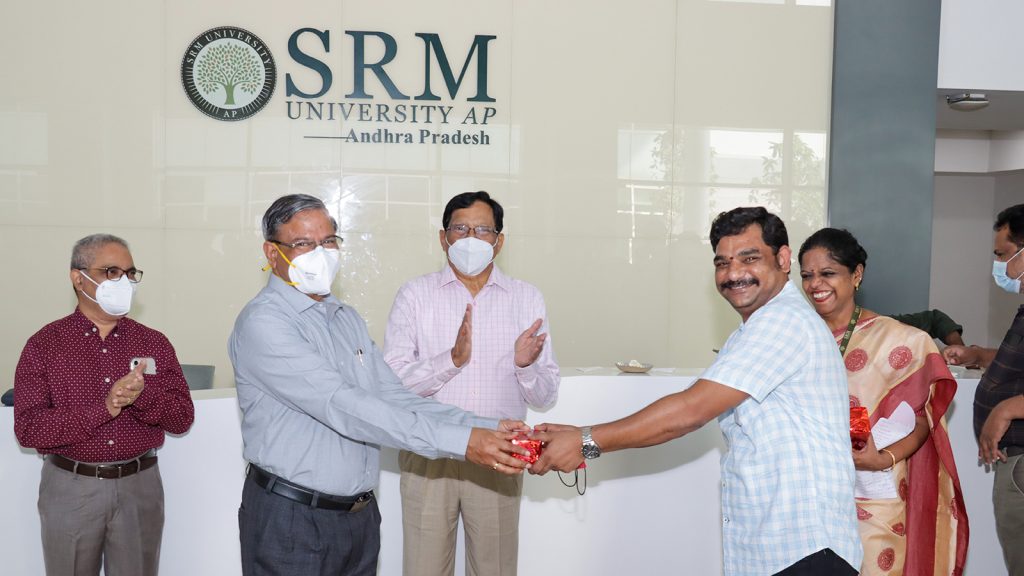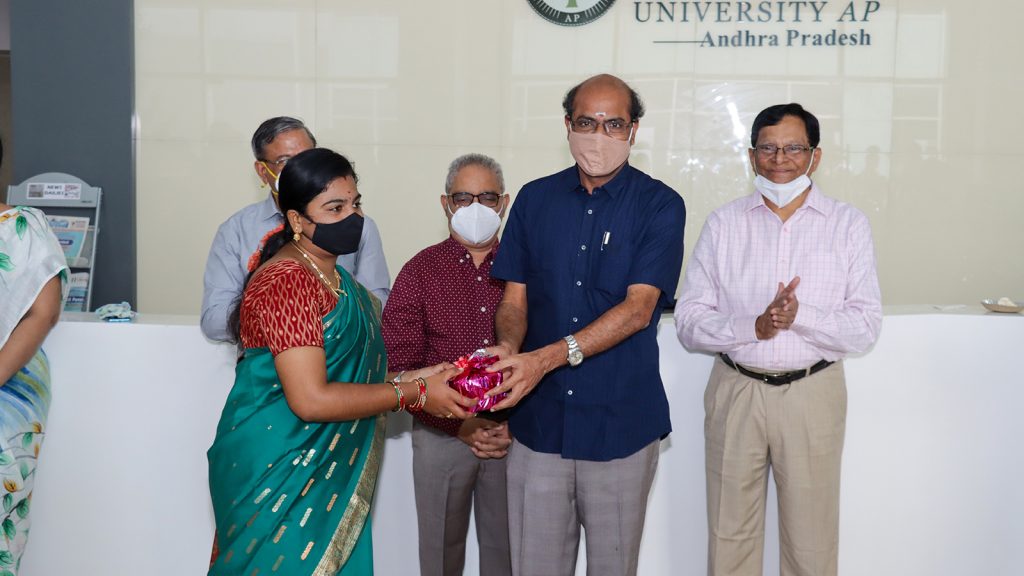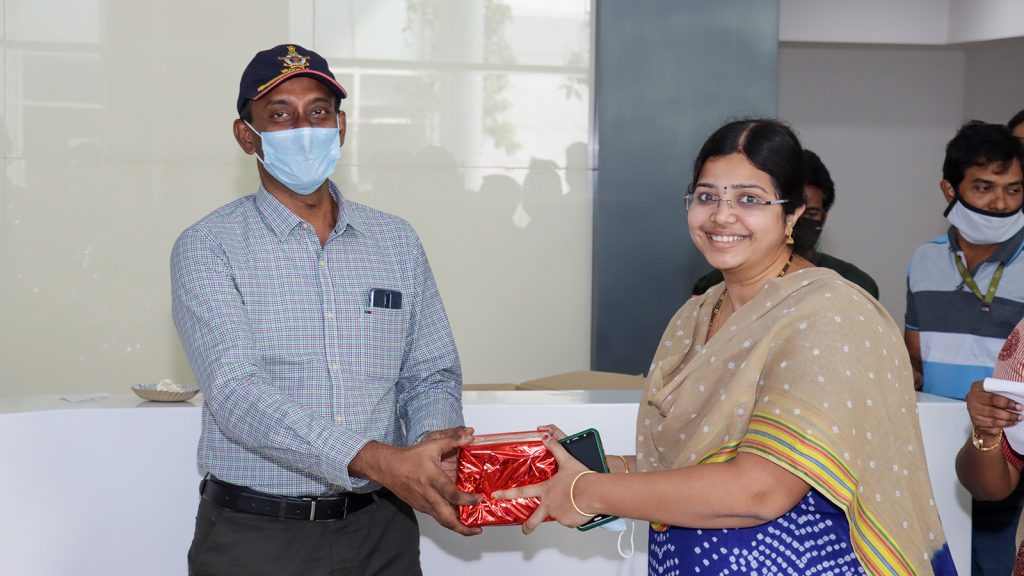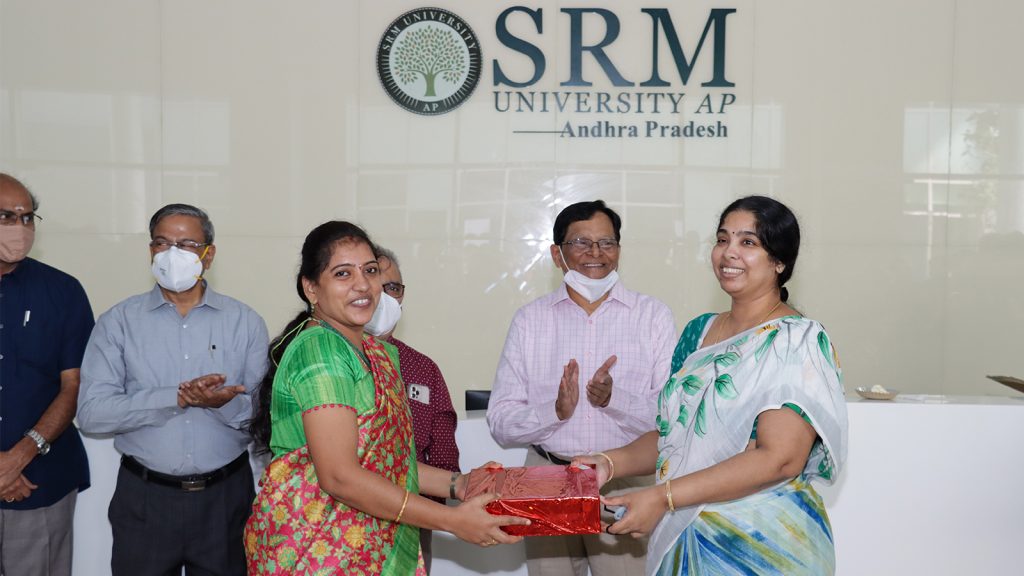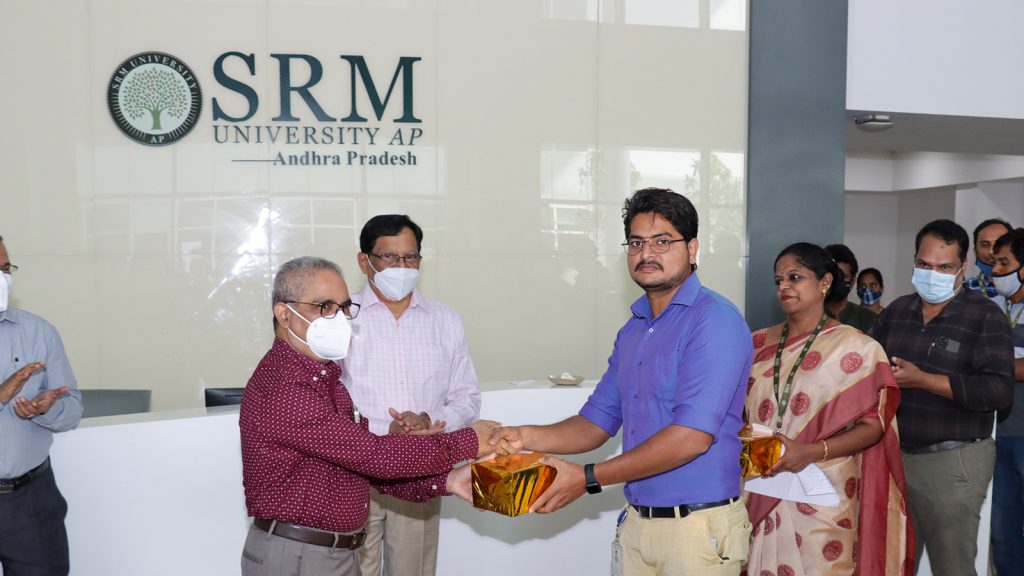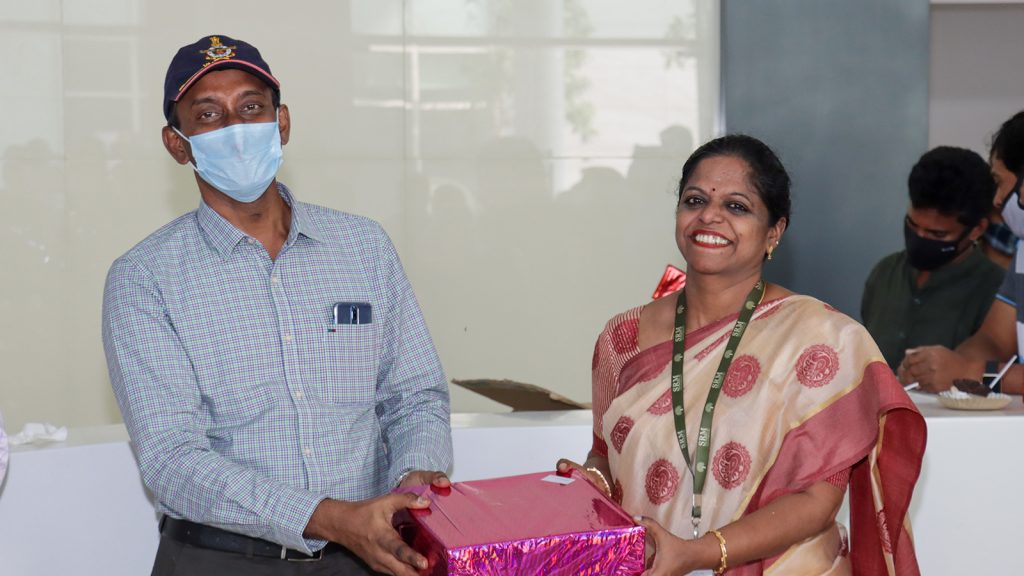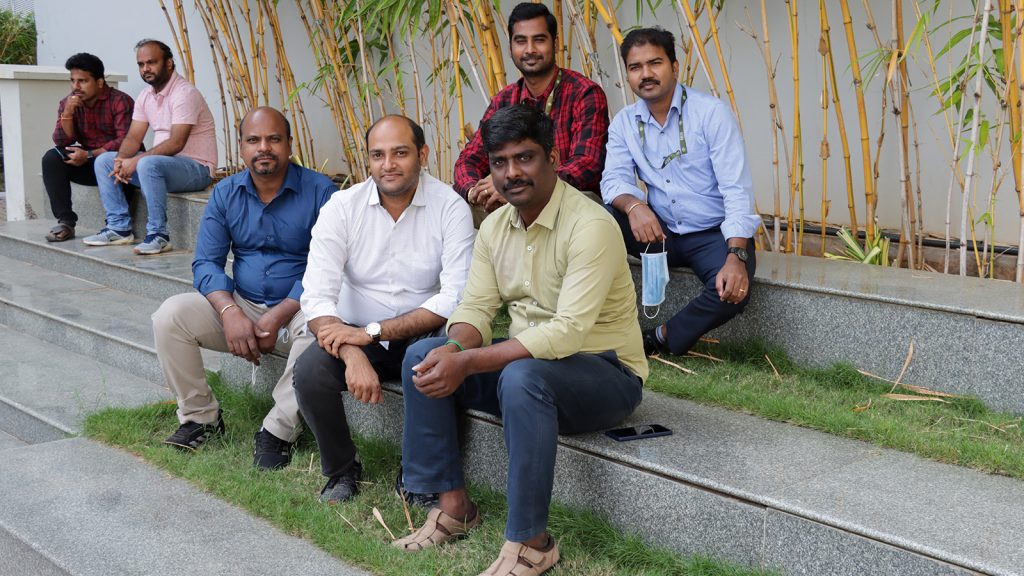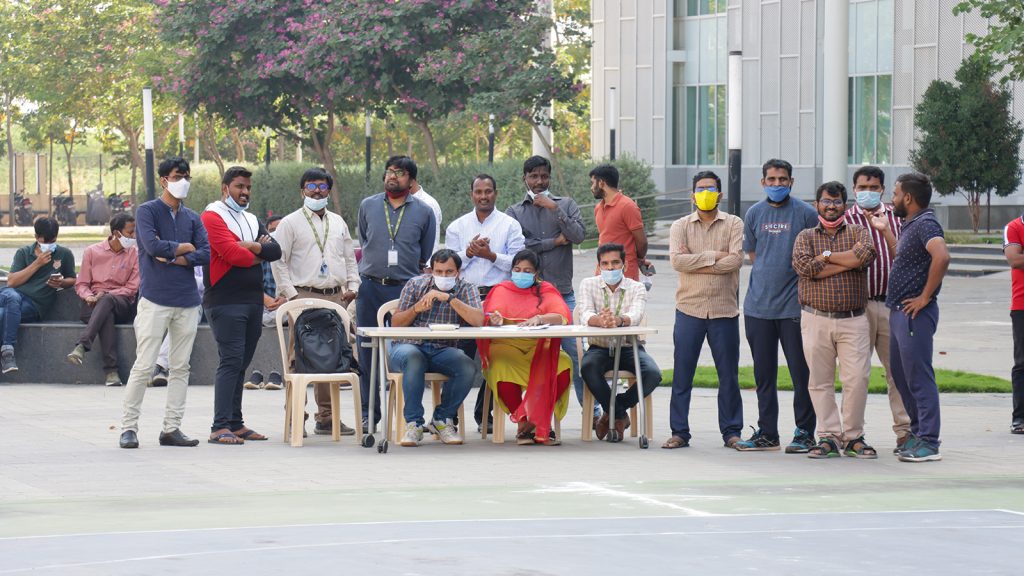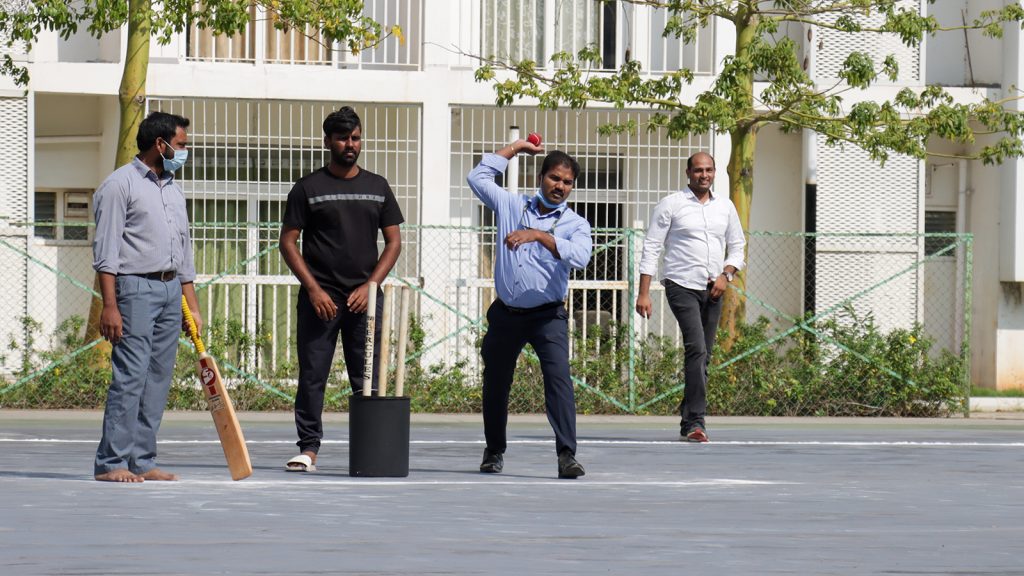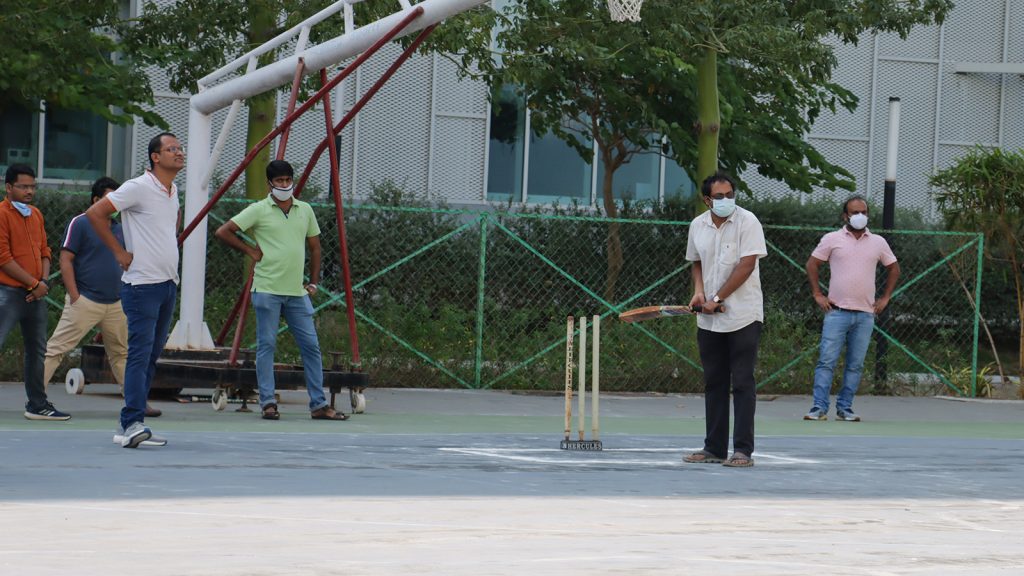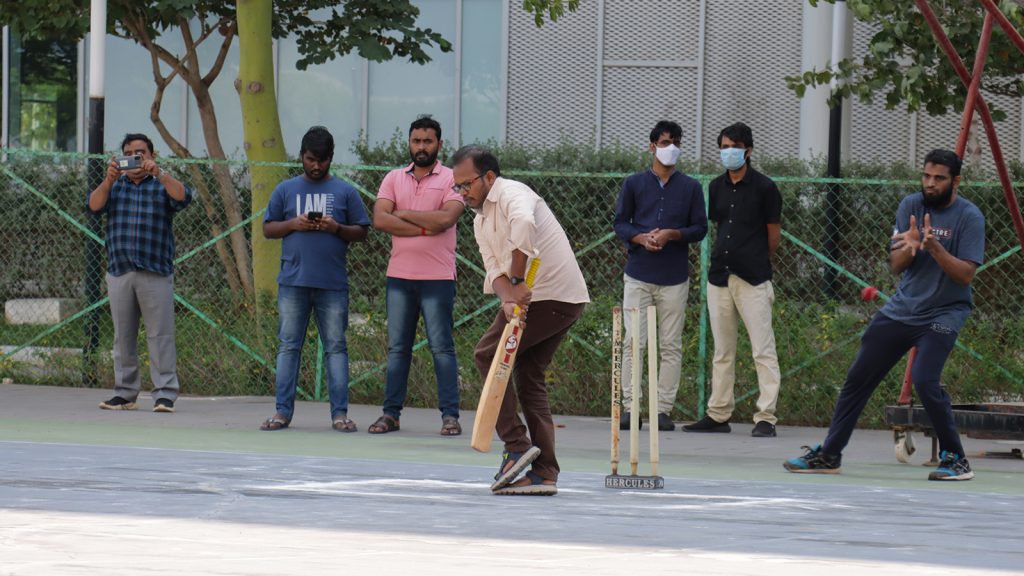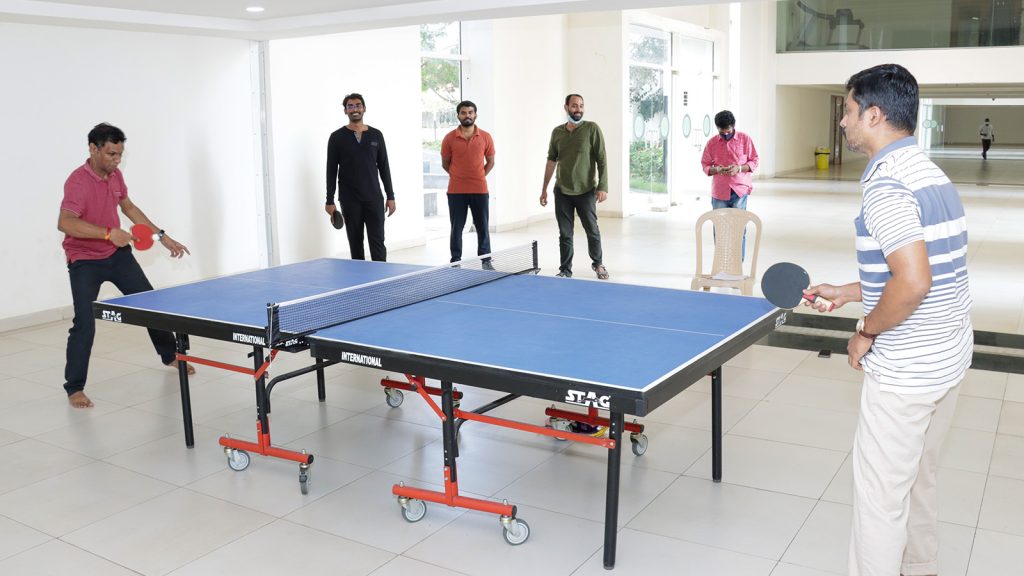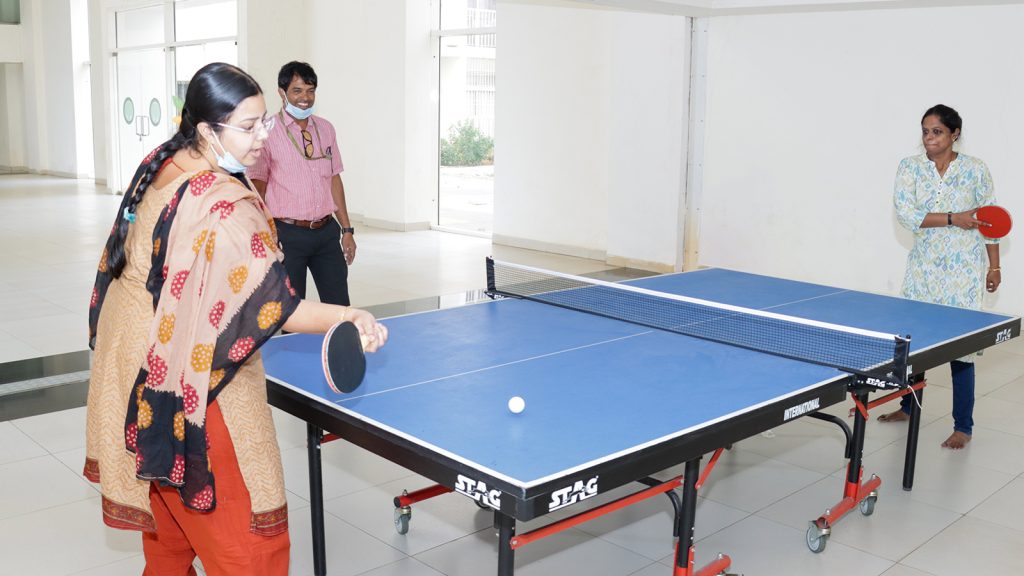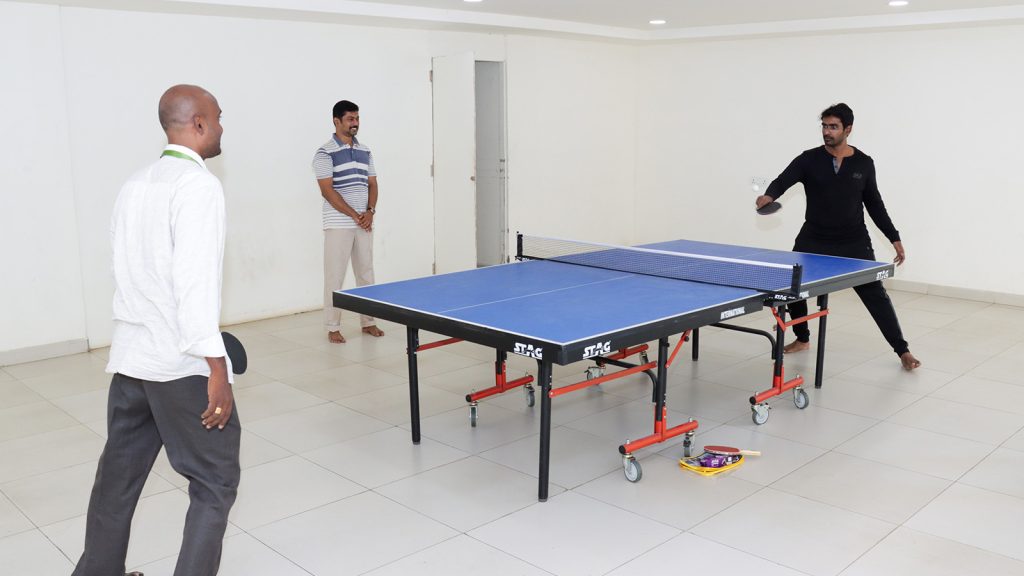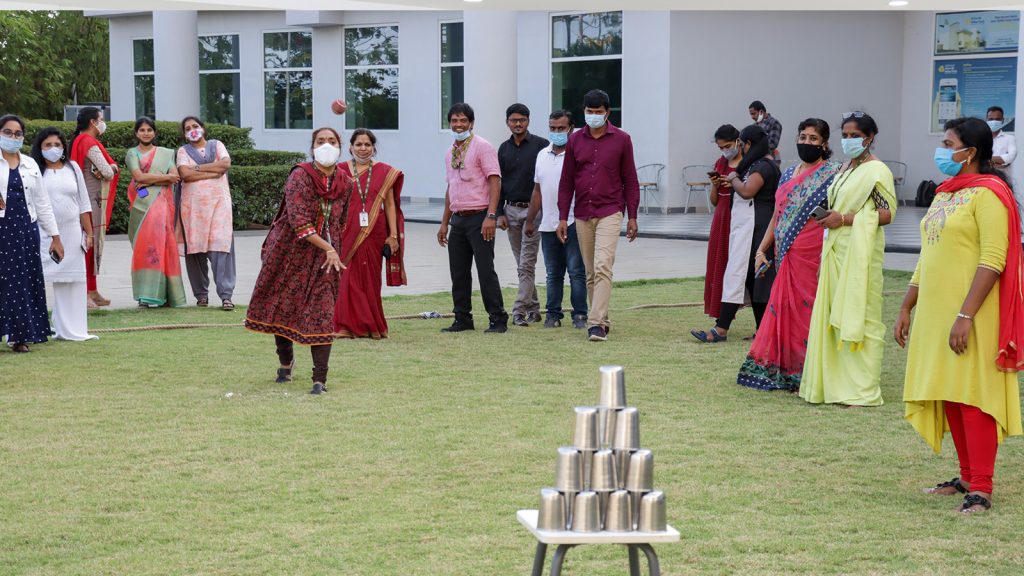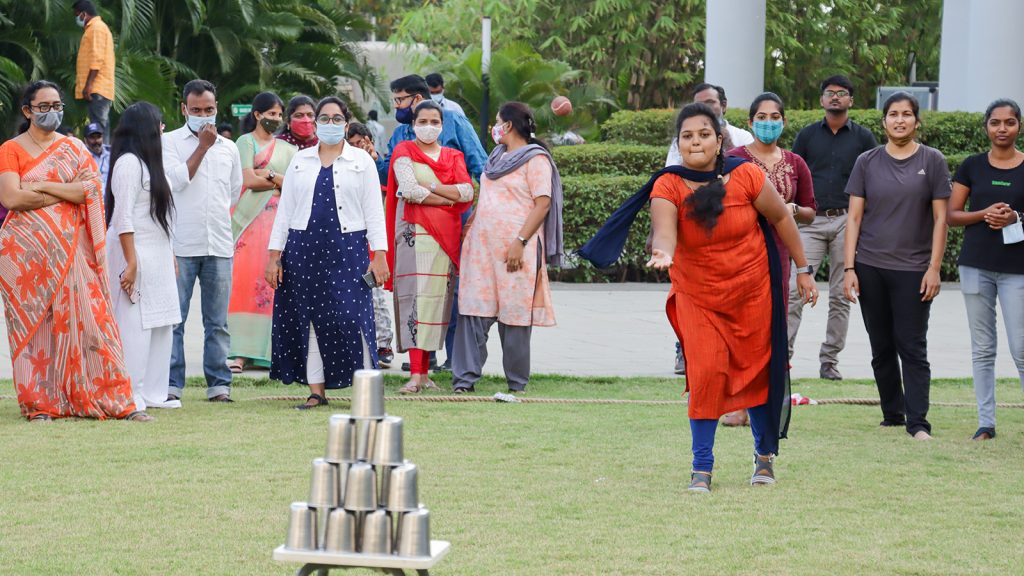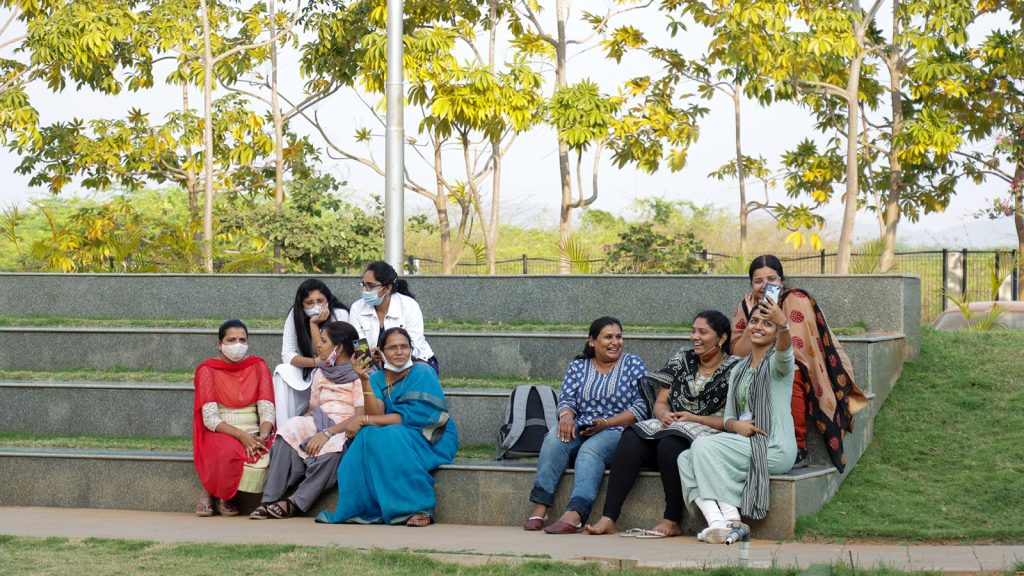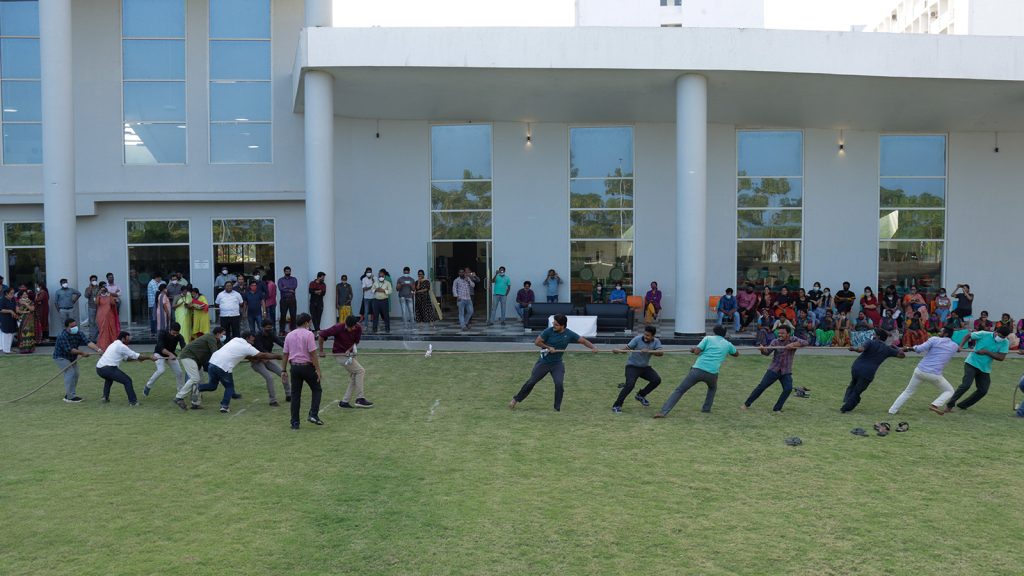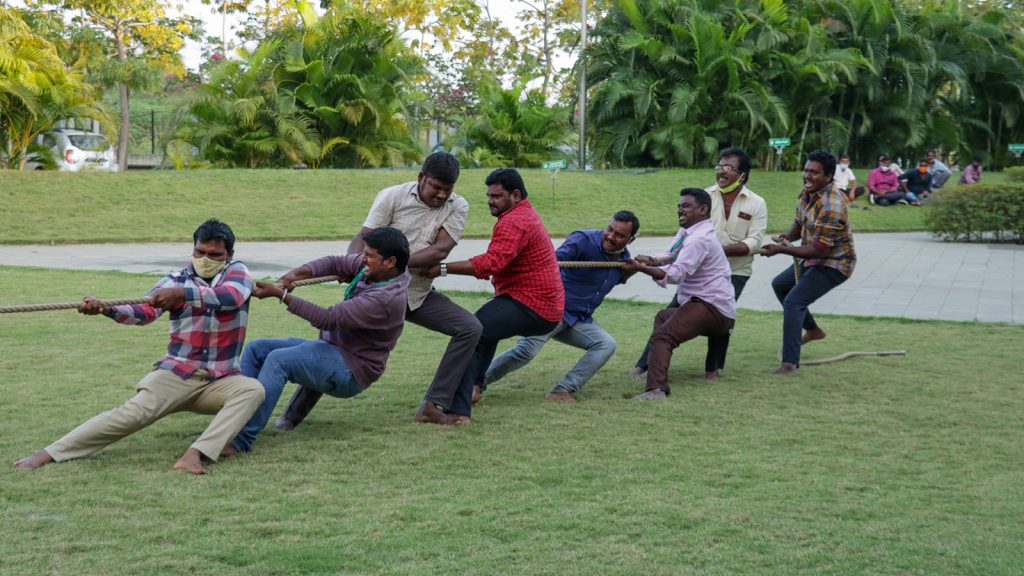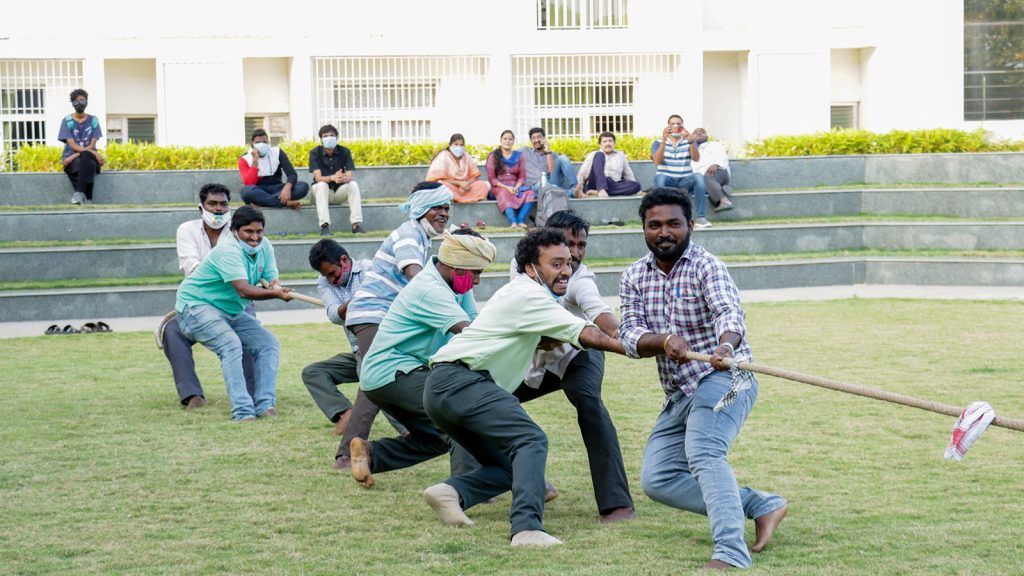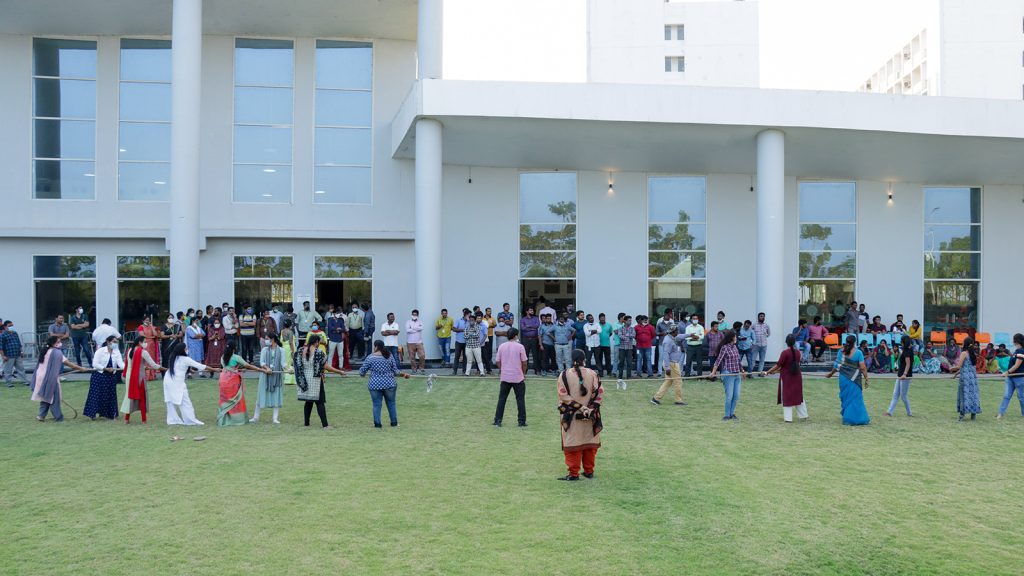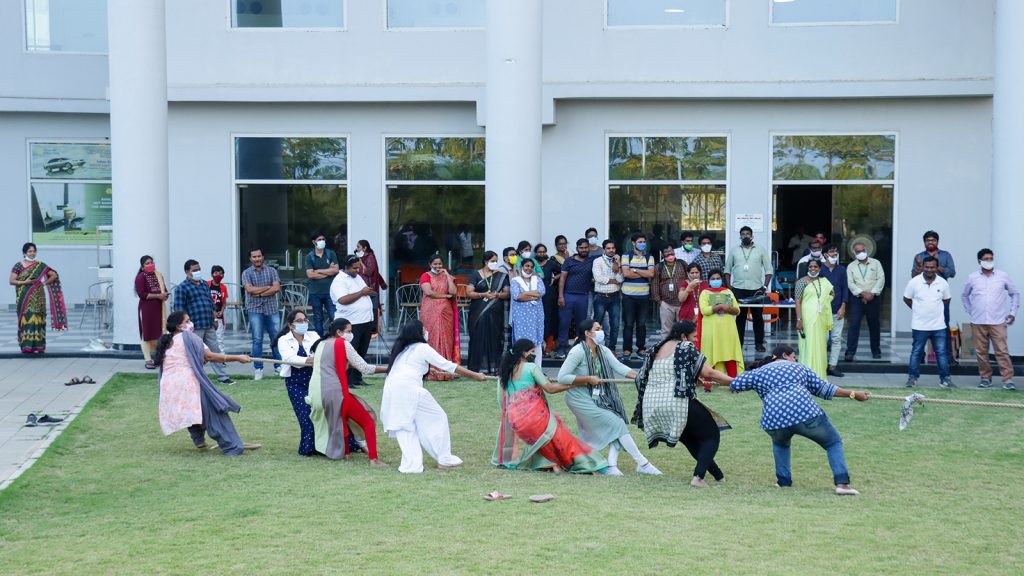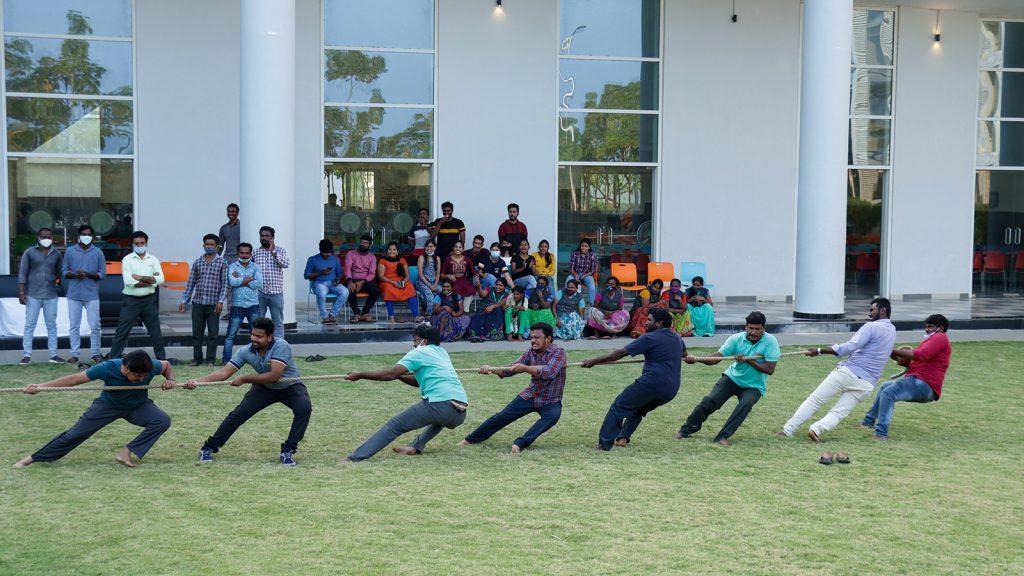Guest Lecture on “DC-DC Converters: Operation, Modelling and Control for Solar and Wind Applications”
The Department of Electrical and Electronics Engineering at SRM University-AP organized a guest lecture titled “DC-DC Converters: Operation, Modelling and Control for Solar and Wind Applications” on December 3, 2021, at 11.00 am IST as part of the Departmental Lecture Series.
An eminent resource person, Dr. Ravindranath Adda, Assistant Professor, Department of Electrical and Electronics Engineering, IIT Guwahati, delivered the intriguing talk as the guest lecture. Many undergraduate students of EEE, research scholars and faculty members of SRM University-AP attended the riveting session.
In his lecture, Dr Adda discussed about the importance of DC-DC converters for solar PV and Wind power applications and emphasized the different non-isolated and isolated converter topologies. He also explained the output power variation of the solar PV or wind turbine as a function of weather conditions, and hence the requirement of DC-DC converters and storage systems to transfer the energy from non-conventional energy sources.
Finally, he discussed about the research scope of DC-DC converters, to increase gain, expedite efficiency, reduce the bulk, dynamic modelling, and large scale and small-scale modelling of DC-DC converters.
The lecture concluded with an energetic note with all the participants looking forward to putting to use all the knowledge and information that they had acquired because of it.
- Published in Departmental News, EEE NEWS, News
Dynamic economic and emission dispatch with renewable energy integration
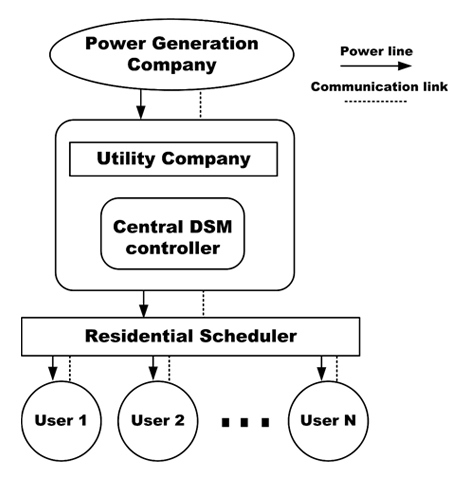 Nowadays, the energy demand of the present electrical power industry is increasing exponentially, and most of the electricity production depends on fossil fuel resources. A research paper titled “Dynamic Economic and Emission Dispatch with Renewable Energy Integration Under Uncertainties and Demand Side Management”, published by Dr B Lokeshgupta, Assistant Professor, Department of Electrical and Electronics Engineering, SRM University-AP, Andhra Pradesh, answers some of the pertinent questions regarding reducing the environmental pollution level.
Nowadays, the energy demand of the present electrical power industry is increasing exponentially, and most of the electricity production depends on fossil fuel resources. A research paper titled “Dynamic Economic and Emission Dispatch with Renewable Energy Integration Under Uncertainties and Demand Side Management”, published by Dr B Lokeshgupta, Assistant Professor, Department of Electrical and Electronics Engineering, SRM University-AP, Andhra Pradesh, answers some of the pertinent questions regarding reducing the environmental pollution level.
Integration of renewable energy resources (RERs) along with demand-side management (DSM) is almost inevitable in the present scenario to meet the growing energy demand with minimum environmental pollution. This work proposes a combined model of dynamic economic and emission dispatch (DEED) and DSM to integrate renewable energy resources (RERs). In this analysis, the DSM load-shifting scheme is incorporated with the DEED problem to obtain the generation side operational benefits as well as the reduction in environmental pollution level. In this study, various smart home appliances and their complex constraints are included in the DSM load shifting process. The variability and stochastic nature of the load demand and RERs such as solar, wind are modelled with Normal, Beta, and Weibull distribution functions, respectively. The proposed model is implemented in both deterministic and stochastic approaches with the help of the non-dominated sorting genetic algorithm (NSGA-II) and the Monte Carlo Simulation (MCS) approach. In the stochastic model, the MCS approach appropriately handles the uncertainties of system load demand and RERs. Four different case studies are carried out in the simulation analysis to show the impacts of RERs and DSM integration on the traditional DEED problem.
Meeting the excessive energy demand with the minimum environmental pollution is a challenging task. The integration of RERs such as wind and solar into the grid is one of the superior solutions for this issue. However, the variability and uncertainty of the RERs bring challenges to the power system operation. Energy management schemes such as demand-side management (DSM) methods can help the power industry address the challenges of RERs integration. That is why the combination of renewable energy integration and DSM is one of the key solutions in the smart grid environment to meet the increased energy demand with the lowest possible energy cost and minimum pollution level. The RERs and DSM combination gives several financial, environmental, and technical benefits to the power industry along with a better system operation.
The dynamic economic and emission dispatch (DEED) is one of the widely adopted tools in the operation and planning of power systems. Both DEED and DSM are the essential tools in the smart grid environment for efficient energy management with the concern of economic and environmental aspects. The DEED’s primary task is to obtain the optimal scheduling of generators with minimum cost and emission for the given load demand. At the same time, the DSM’s primary goal is to improve the optimal values of system objective functions by shifting or managing the controllable loads of consumers. This work introduces a combined stochastic optimisation model of DEED and DSM scheme with the integration of solar and wind energy to show how DSM and RERs bring benefits to a generation company, and also to get better optimal operation cost and emission values simultaneously. The DSM load-shifting scheme is implemented in this study with the help of 10,000 active residential consumers. The effectiveness of the proposed combined model has been tested on a system of six thermal generating units, one wind-powered generator, and one solar-powered generator. The MCS approach and NSGA-II method are used in this paper to solve the proposed stochastic combined DEED and DSM optimisation model.
From the overall analysis, it is recognized that the implementation of the DSM load-shifting scheme along with RERs integration is essential for future smart grids to improve the financial savings of generation companies as well as to reduce the environmental pollution level. The paper is written in collaboration with Dr S Sivasubramani, Associate Professor, Department of Electrical Engineering, Indian Institute of Technology, Patna.
In future, the proposed DSM optimisation can be extended with the inclusion of a neighbourhood power-sharing model in the environment of multiple smart home consumers and prosumers. The proposed DSM model can also be integrated with the distribution network planning and operation problems to enhance the financial and technical benefits of distribution companies.
- Published in EEE NEWS, News, Research News
Dr Chennupati Jagadish on Semiconductor Nanostructures for Optoelectronics Applications
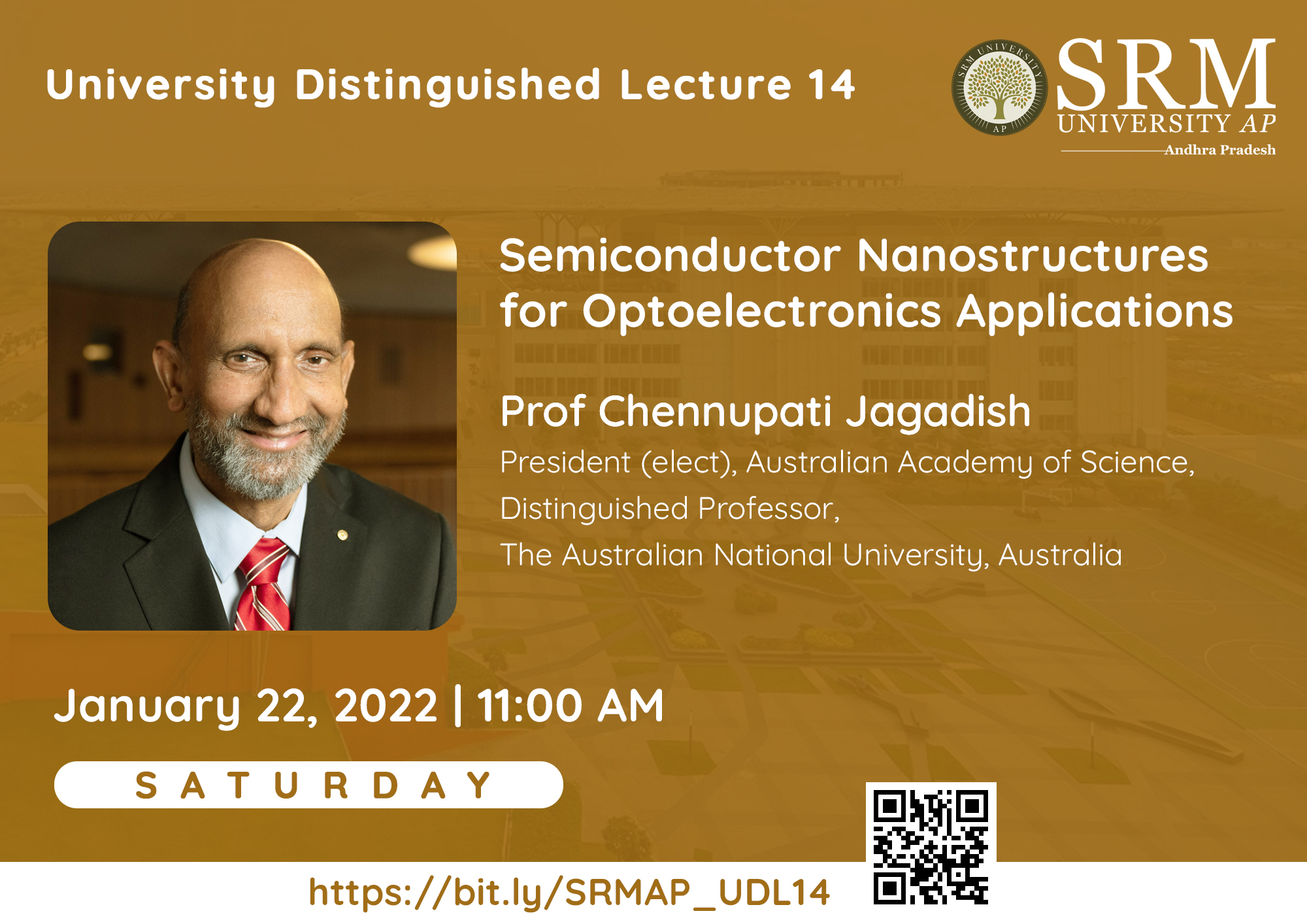 In the next installment of the University Distinguished Lecture, SRM University-AP brings to you Dr Chennupati Jagadish, a distinguished professor in Physics in the Research School of Physics and Engineering at the Australian National University. He leads the Semiconductor Optoelectronics and Nanotechnology Group as its head since its establishment in 1990 by him.
In the next installment of the University Distinguished Lecture, SRM University-AP brings to you Dr Chennupati Jagadish, a distinguished professor in Physics in the Research School of Physics and Engineering at the Australian National University. He leads the Semiconductor Optoelectronics and Nanotechnology Group as its head since its establishment in 1990 by him.
Date: January 22, 2022 (Saturday)
Time: 11.00 am IST
About the Topic:
Semiconductors have played an important role in the development of information and communications technology, solar cells, solid state lighting. Nanowires are considered as building blocks for the next generation electronics and optoelectronics. In this talk, I will present the results on optoelectronic devices such as lasers/LEDs, THz detectors, energy devices such as solar cells, photoelectrochemical (PEC) water splitting and Neuro-electrodes. Future prospects of the semiconductor nanowires will be discussed.
About the Speaker:
Dr Chennupati Jagadish obtained his Bachelor of Science degree in Physics from the Acharya Nagarjuna University in Tenali, Andhra Pradesh in the year 1977. He received his Master of Science in Applied Physics with a specialisation in Electronics from Andhra University in the year 1980. He acquired his PhD in Physics, by working on ‘Semiconducting Thin Films’, from the University of Delhi in the year 1986. He also held the position of a post-doctoral fellow in the Queens University.
Dr Jagadish moved to the Australian National University in the year 1990 and joined the newly established Department of Electronic Materials Engineering in the Research School of Physics and Engineering. He was the Vice-President and Secretary at the Australian Academy of Science for Physical Sciences for four years.
Committed to his role as an academician, Dr Jagadish also holds many honorary and guest faculty positions around the world in leading Universities such as the Oxford University, the Cambridge University, South Central University (The Republic of China), the University of Electronic Science and Technology of China, the University of Tokyo and the Taiwan National University to name a few.
He makes a frequent appearance, by invitation, to various international conferences and seminars on Material Sciences, Electronics, Quantum Electronics, Semiconductors, Physics, Photonics, and Material Sciences. As an active member of the Material Research Society, IEEE, he has delivered many talks and guest lectures as well as organised several sessions in MRS, IEEE meetings throughout the world.
Dr Chennupati Jagadish is currently the Editor-in-Chief for Applied Physics Reviews. He was earlier the Editor-in-Chief for Progress in Quantum electronics and Co-Editor-in-chief for the International Journal of High-Speed Electronics and Systems. He is also the Editor for the Journal of Semiconductor Technology and Science, Springer Series in Material Science, Springer Series in Nanoptics and Nanophotonics, Elsevier Series in Semiconductors and Semimetals, IEEE Electron Device Letters, and Light: Science and Applications of Nature Publishing Group. He is a member of the Editorial Boards of over 20 journals including ACS Nano, Physica Status Solidi: Rapid Res. Lett., IEEE Nanotechnology Magazine, IEEE Photonics Journal, Solid State Electronics, among others.
Dr Jagadish holds many laurels to his name. He became a Champion of the Order of Australia for his eminent contributions to Physics and Engineering at the Australia Day Honours 2016. He has acquired the IEEE Pioneer Award in Nanotechnology (2015), the Walter Boas Medal from the Australian Institute of Physics (2013) and the Thomas Ranken Lyle Medal from the Australian Academy of Science (2019).
He became an elected Fellow of the American Physical Society (2003). In 2020, he also became an elected member of the National Academy of Engineering for his contributions to the nanotechnology of optoelectronic devices. The Australian Research Council awarded him with the Federation Fellowship (2004-09) and with the Laureate Fellowship (2009-14).
It would be a privilege to have Dr Chennupati Jagadish, an astoundingly celebrated research personality, in our midst. We urge everyone to make the most of this opportunity. The University Distinguished Lecture (UDL) hosted by SRM University-AP is attended by about 2000 members from IITs, NITs, IISERs, Universities/Institutions, CSIR, DST, DBT, DRDO, DAE, ISRO, NARL, MoES and several others from different parts of the country.
SRM University-AP cordially invites everyone to the fourteenth University distinguished Lecture on January 22, 2022, Saturday at 11.00 am IST.
Register to Join: https://bit.ly/SRMAP_UDL14 (Registration Closed)
- Published in Events, Research Events, University Distinguished Lecture
Efficient algorithms for dualisation problem for subclasses of Boolean functions
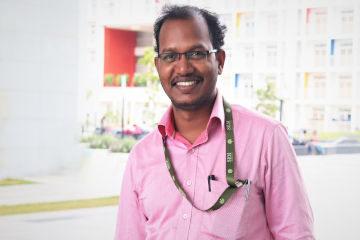 SERB-DST projects aim to build up the best systems that would match the best global practices in the area of promotion and funding of basic research. Dr Murali Krishna Enduri, Assistant Professor, Department of Computer Science Engineering at SRM University-AP is yet another faculty member who has obtained a project with a total outlay of ₹18 lacs for a duration of three years. The project is sanctioned under the scheme of Teachers Associateship for Research Excellence (TARE) of SERB-DST, Government of India.
SERB-DST projects aim to build up the best systems that would match the best global practices in the area of promotion and funding of basic research. Dr Murali Krishna Enduri, Assistant Professor, Department of Computer Science Engineering at SRM University-AP is yet another faculty member who has obtained a project with a total outlay of ₹18 lacs for a duration of three years. The project is sanctioned under the scheme of Teachers Associateship for Research Excellence (TARE) of SERB-DST, Government of India.
In the duality theory, the dual problem is the problem of checking the duality of a pair of monotone Boolean expressions in disjunctive normal form. Problem: DUAL Input: The complete DNF of two monotone Boolean functions, f and g. Output: If f is dual of g. Whether the problem DUAL admits a polynomial-time algorithm has been one of the challenging open problems in the field of Duality theory of Boolean function for the last 35 years. It is one of the few problems whose polynomial-time solvability is still unknown. So, this problem is important in complexity theory due to its unknown complexity status and it plays a central role in various applications arising in computational logic, data mining, reliability theory, artificial intelligence and game theory etc. The project goal is to solve the dual problem for an interesting class of Boolean functions. Improving the existing complexity results of the DUAL problem for a particular class of Boolean functions is a challenging task.
Few applications of the project are as follows:
Type error diagnosis: Type error diagnosis is the task of generating an explanation for some error. It requires finding all minimal unsatisfiable subsets of a given set of constraints (representing the error) which can be managed via solving the computational variant of Dual in its minimal transversal formulation.
Computational medicine: Optimal vaccination strategies are given a subset of initially infected individuals from a population of individuals and assumptions about disease transmission. The task of computing inclusion minimal vaccination strategies can be solved using the computational variant of Dual in its transversal hypergraph formulation.
The project will be carried out in collaboration with IIT Madras (Dr Jayalal Sarma, Associate Professor, Department of Computer Science & Engineering, Indian Institute of Technology Madras, Chennai, India.)
- Published in CSE NEWS, Departmental News, News, Research News
Dr Nimai Mishra on The Impact of Shell Thickness on Charge Transfer Dynamics in Green Emitting Core/Shell Giant Quantum Dots
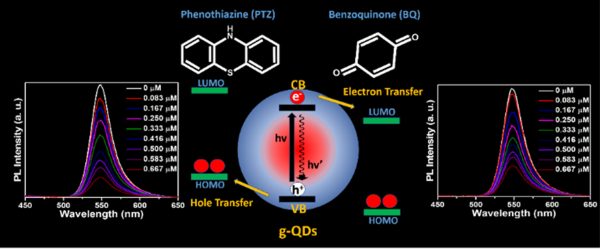 Dr Nimai Mishra, Assistant Professor, Department of Chemistry, SRM University-AP, Andhra Pradesh, along with his research group comprising of students pursuing PhD under him, Mr Rahul Singh, Mr Syed Akhil, and Ms V. G. Vasavi Dutt, have published a research article titled “Study of Shell Thickness Dependent Charge Transfer Dynamics in Green Emitting Core/Shell Giant Quantum Dots” Nature Index journal, “Inorganic Chemistry” published by The American Chemical Society having an impact factor of 5.1.
Dr Nimai Mishra, Assistant Professor, Department of Chemistry, SRM University-AP, Andhra Pradesh, along with his research group comprising of students pursuing PhD under him, Mr Rahul Singh, Mr Syed Akhil, and Ms V. G. Vasavi Dutt, have published a research article titled “Study of Shell Thickness Dependent Charge Transfer Dynamics in Green Emitting Core/Shell Giant Quantum Dots” Nature Index journal, “Inorganic Chemistry” published by The American Chemical Society having an impact factor of 5.1.
About the paper:
The superior photostability enables green-emitting graded alloy core/shell giant quantum dots (g-QDs) for optoelectronic application. However, it is essential to understand how the shell thickness affects interfacial charge separation. This work explores the impact of shell thickness on photoinduced electron transfer (PET) and photoinduced hole transfer (PHT) with an electron acceptor benzoquinone and a hole acceptor phenothiazine, respectively. The four graded alloy core/shell green-emitting g-QDs with different shell thicknesses were synthesised. The PET and PHT rate constants were obtained from photoluminescence and PL-lifetime decay measurement. Our study concludes that g-QDs with a diameter ~7.14 show a substantial improvement in charge transfer than g-QDs ≥ 8.5 nm in diameter. Similarly, the PET and PHT rates are 3.7 and 4.1 times higher for 7.14 nm g-QDs than for the 10.72 nm sample. The calculated electron and hole transfer rate constant (ket/ht) of g-QD with 7.14 nm in diameter are 10.80 × 107 s-1 and 14 × 107 s-1, which shows 8.5 and 8 times higher compared to g-QDs with a 10.72 nm in diameter.
Industrial implications:
More importantly, these results highlight the impact of shell thickness on the excited state interactions of green-emitting g-QDs and conclude that g-QDs with a relatively thin shell can be a better choice as photoactive materials for photocatalysts, photodetectors, and solar cells.
Want the complete details of Dr Nimai Mishra’s paper?
- Published in Chemistry-news, Departmental News, News
Ms Tanoogna bags three gold medals at National Indoor Archery Championship-2021
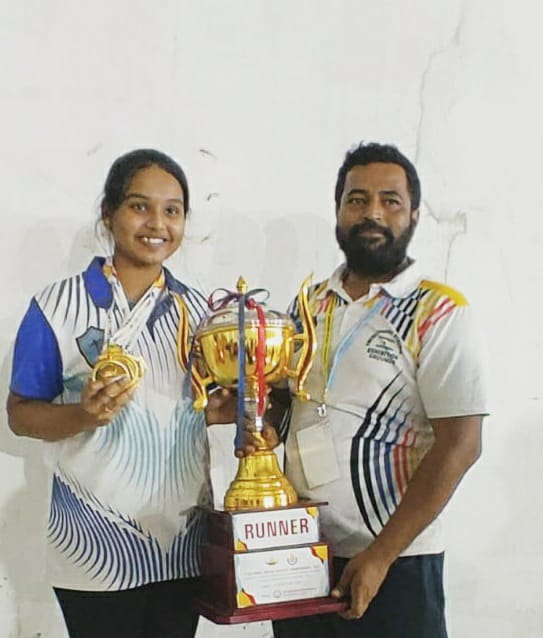 Mallarapu Tanoogna, a third-year civil engineering student at SRM University-AP, has excelled at National Indoor Archery Championship-2021, winning three gold medals and finishing 8th in the National Open Ranking, representing Andhra Pradesh. The National Field Archery Development & Welfare Association in Salem, Tamilnadu, hosted the inaugural National Indoor Archery Championship-2021 on 25th and 26th December. Archery players from the South Indian states of Kerala, Tamil Nadu, Karnataka, Andhra and Telangana participated in the competition.
Mallarapu Tanoogna, a third-year civil engineering student at SRM University-AP, has excelled at National Indoor Archery Championship-2021, winning three gold medals and finishing 8th in the National Open Ranking, representing Andhra Pradesh. The National Field Archery Development & Welfare Association in Salem, Tamilnadu, hosted the inaugural National Indoor Archery Championship-2021 on 25th and 26th December. Archery players from the South Indian states of Kerala, Tamil Nadu, Karnataka, Andhra and Telangana participated in the competition.
Ms Tanoogna, representing Andhra Pradesh from SRM AP has been training to participate in indoor and outdoor archery championships for a year. She won gold medals in the Senior Recurve women individual, women team and mixed team categories and is ranked 8th in the national archery rankings.
“It is a pride moment that our student wins gold medals and opens national ranking,” said university Vice-Chancellor-Prof V S Rao, congratulating Ms Tanoogna. Registrar-Dr R Premkumar, Deans, and faculty members congratulated Ms Tanoogna and promised her all the support for attending more national and international championships in the future.
- Published in CIVIL NEWS, News, Students Achievements
STEM-Research Society Best Paper Award to faculty and undergraduate students
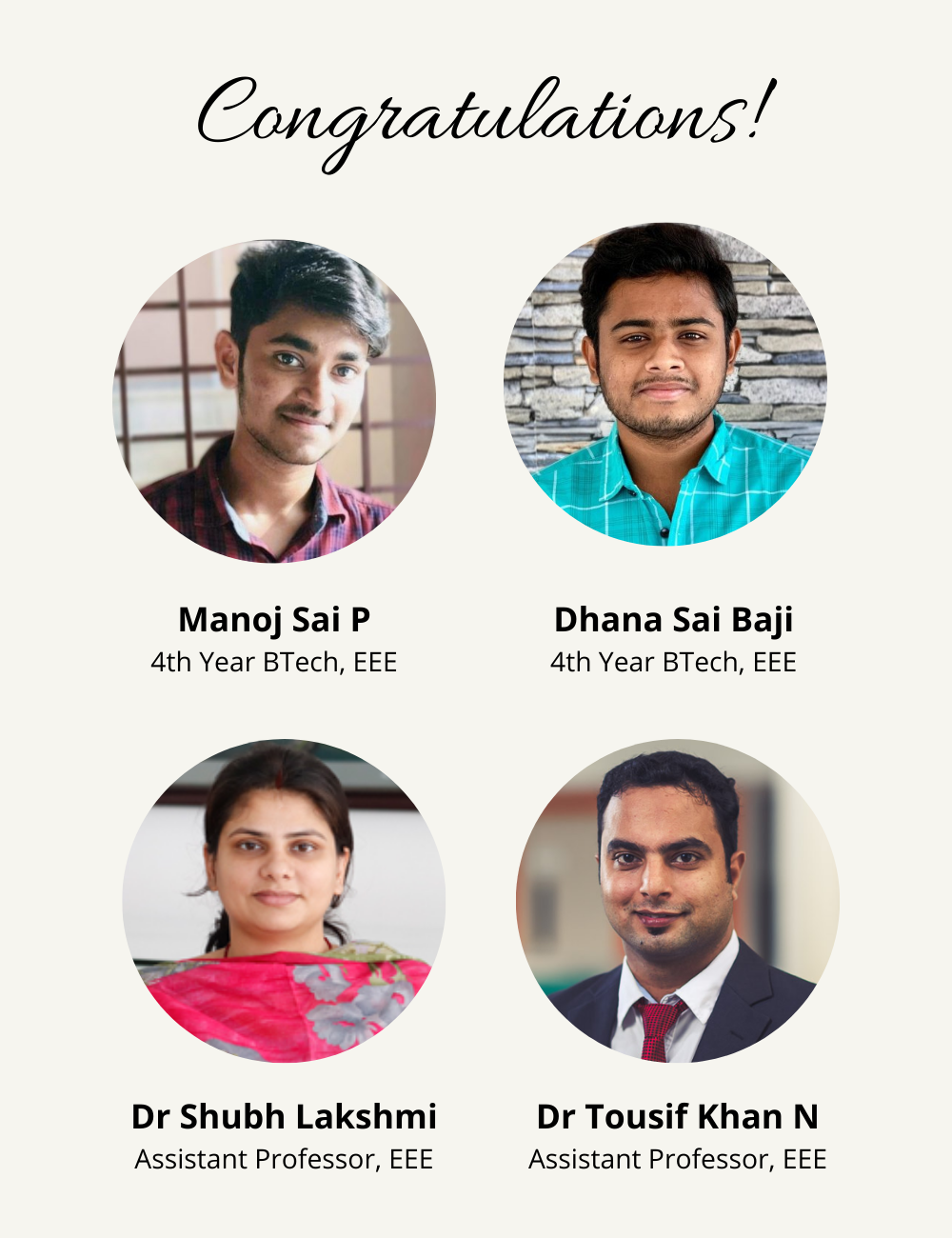 “As an undergraduate student, I initially faced many difficulties selecting the area of interest, analysing and organising a paper, and academic writing skills. The continuous support from faculty at SRM university-AP helped me overcome these issues. This achievement would have been impossible without the support and efforts of my faculty mentors. My heartful gratitude to Dr Shubh Lakshmi madam and Dr Tousif Khan N sir for their kind support and encouragement in research work. I am grateful to start my research career under their guidance. Also, the management encourages and supports us every time in every possible way by providing scholarships.”
“As an undergraduate student, I initially faced many difficulties selecting the area of interest, analysing and organising a paper, and academic writing skills. The continuous support from faculty at SRM university-AP helped me overcome these issues. This achievement would have been impossible without the support and efforts of my faculty mentors. My heartful gratitude to Dr Shubh Lakshmi madam and Dr Tousif Khan N sir for their kind support and encouragement in research work. I am grateful to start my research career under their guidance. Also, the management encourages and supports us every time in every possible way by providing scholarships.”
–Pendem Manoj Sai
A paper titled “Exhaustive Search Approach to Place PV in Distribution Network for Power Loss Minimization” has been awarded STEM-Research Society Best Paper Award in the recently held conference, Soft Computing: Theories and Applications (SoCTA)-2021, at the Indian Institute of Information Technology, Kota on the dates December 17-19, 2021. The authors of the paper are- P Manoj Sai, M Dhana Sai Baji, Dr Shubh Lakshmi, and Dr Tousif Khan Nizami from the Department of Electrical and Electronics Engineering, School of Engineering and Sciences, SRM University-AP, Andhra Pradesh, India. The paper is selected for publication in Lecture Notes in Networks and Systems, Springer (Indexed in SCOPUS).
This paper proposes an exhaustive search approach to determine the best location and size of PV placement for power loss minimisation of radial distribution networks. In this approach, the network power loss is determined by placing PV in each location, one at a time, and the size of PV in the same location is varied between a set minimum and maximum limits. The combination of location and size of PV, which provide the minimum network power loss, can be the best location and size of PV for power loss minimisation of radial distribution networks. The forward-backwards sweep load flow algorithm with the PV model is used to determine the power loss for each combination of location and size of PV.
The paper was presented by Mr P Manoj Sai, a BTech EEE 4th year student from SRM University-AP, Andhra Pradesh. He is thrilled to receive the best paper award and extended his gratitude to Dr Tousif Khan N, the Head of the Department, and Dr Shubh Lakshmi, Assistant professor in the Department of Electrical and Electronics Engineering, for their continuous guidance. Further, he extended his thanks to the management and Pro Vice-chancellor of SRM University-AP for providing financial support.
- Published in Departmental News, EEE NEWS, News, Students Achievements
Welcoming 2022 with joy, hope, and fun
On Saturday morning, students, faculty and administrative staff members at SRM University-AP welcomed the new year with colourful celebrations on campus. Vice-Chancellor Prof V S Rao cut the New year special cake and addressed the gathering. “We shall enter the new year with the hope that pandemic will be endemic in 2022”, he said. He also suggested that everyone take steps in a planned manner to receive the success they hope for in the new year.
Dr R Premkumar, the Registrar, expressed hope that the university would move towards higher standards under the supervision of Professor B V Babu, Dean of the School of Engineering and Sciences. The organisers and participants of the event and various game activities adhered strictly to the Covid-19 protocol. Prizes were given away to the winners of various competitions.
The event was attended by Registrar-Dr R Premkumar, Dean-Prof B V Babu, Controller of Examinations- Dr Vinayak Kalluri, Directors-Mrs Suma N, Dr K Mohan, Wg Cmdr Venkataachalam Sekkappan, Prof Y Siva Sankar and others.
Journey of Dr Manjula R towards Privacy in Wireless Sensor Networks
Anecdote:
“Since my school days, I have been fascinated by writing cryptic text, though intelligible. It all started with mirror-writing the teaching-feedback that was requested by our class teacher Tr. Jezuine. Once the feedback was read, the teacher called me and asked: “How did you learn this?” I was on cloud nine and replied, “it just happened only for you”, with a massive smile on my face. Later, I never thought of any secret writing for a while. It was only during the initial days of my teaching profession; I had the opportunity to read my classmate’s notes scribbled in a cryptic text which triggered further enthusiasm in me. So, during my postgraduate course, I started reading and presenting seminars on Cryptography and Security. This further led to deeper digging into the core of security aspects that also led to a trivial postgraduate project on key-establishment in wireless sensor networks. Later during the research period, I chose a new upcoming area – wireless sensor networks (broader domain), and contextual- and content- privacy (narrower domain) – privacy preservation in WSNs as my research topic.”
-Dr Manjula R
The Issue:
The significance: The privacy of individuals is being compromised gradually with the increasing popularity and rapid deployment of pervasive computing technologies. The benefits and conveniences offered by modern devices often lead people to neglect the dire consequences of possible privacy violations. Therefore, privacy risks should be taken into considerations while designing responsible technologies. One such technology that poses serious privacy risks is the Wireless Sensor Networks (WSNs). Despite the enormous benefits offered by WSNs to humanity, several issues need meticulous attention. Security and privacy are such issues in WSNs. For instance, the US military aims to adopt Internet of Things (IoT) enabled WSN. The usage of WSNs, Unmanned Aerial Vehicles (UAVs), tiny robots (nanoscale robots) are envisioned to transform the battlefield scenario. In particular, these digital devices and components are embedded in soldiers’ uniforms to collect the health status of the worriers and relay this information to a central controller, named the base station (BS). The BS is located near places where the internet is easily accessible. Nevertheless, WSNs are deployed in areas where it is challenging to have internet. However, this problem is easily solved with the amalgamation of WSNs and IoT. This comes with unwelcoming consequences. The unattended nature of these networks provides an attacker with physical access to the devices. The attacker may compromise the node and conduct illegal activities, say, mimic fake chemical leakages etc. Furthermore, the broadcast nature of the transmission medium gives access to the packets exchanged by the sensor nodes to anyone within the communication range. Consequently, adversaries may exploit these features of WSNs in order to launch attacks against the network and thus render all the potential benefits offered by this technology unusable. Hence, privacy preservation in WSNs is a significant issue that needs to be addressed to safeguard personal and private assets—soldiers or endangered animals etc.
In a quest to provide countermeasures to such attacks, Dr Manjula R and her team are developing privacy preserved solutions with particular emphasis on routing in WSNs. Their recent research article titled “Protecting Source Location Privacy in IoT Enabled Wireless Sensor Networks: The Case of Multiple Assets” has been accepted for publication in a peer-reviewed journal – IEEE Internet of Things Journals. This work is co-authored by Prof. Raja Datta, IIT Kharagpur and Mr Tejodbhav Koduru (studying in 5th semester in dept. of CSE, SRM University AP). The SCI-indexed journal has an impact factor of 9. 396. The team is also focusing on the development of new countermeasures to mitigate eavesdropping attacks in WSNs.
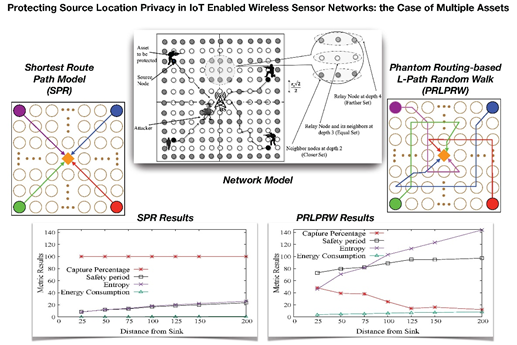
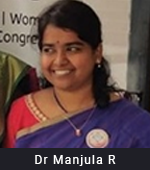
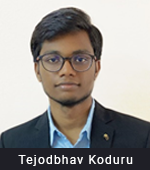
Dr Lakhveer Singh published in Advanced Functional Materials for Engineered Nanoenzymes
 The Department of Environmental Science is proud to announce that Dr Lakhveer Singh has published his paper titled, “Engineered Nanoenzymes with Multifunctional Properties for Next-Generation Biological and Environmental Applications” in Advanced Functional Materials with an impact factor of 18.50.
The Department of Environmental Science is proud to announce that Dr Lakhveer Singh has published his paper titled, “Engineered Nanoenzymes with Multifunctional Properties for Next-Generation Biological and Environmental Applications” in Advanced Functional Materials with an impact factor of 18.50.
About the Paper:
Enzyme mimicking studies took on a new aspect as it turns out that inorganic nanomaterials could have intrinsic enzyme-like activities. The word nanozyme (nanoenzyme) was first coined to describe the ribonuclease-like activity of ligand functionalised gold nanoparticles in 2004. Since then, various research has been continued on nanomaterials with enzyme-like activity. Thus, nanoenzyme has come to describe nanomaterials with enzyme-like activity.
Abstract:
As a powerful tool, nanoenzyme electrocatalyst broadens the ways to explore bioinspired solutions to the world’s energy and environmental concerns. Efforts to fashion novel nanoenzymes or engineering nanoenzymes for effective electrode functionalisation is generating innovative, viable catalysts with high catalytic activity, low cost, high stability and versatility, and ease of production. High chemo-selectivity and broad functional group tolerance of nanoenzyme with an intrinsic enzyme-like activity make them an excellent environmental tool. The catalytic activities and kinetics of nanoenzymes that benefit the development of nanoenzyme-based energy and environmental technologies by effectual electrode functionalisation are discussed in this article. Further, deep insight on recent developments in the state-of-art of nanoenzymes either in terms of electrocatalytic redox reactions (viz. oxygen evolution reaction, oxygen reduction reaction, nitrogen reduction reaction and hydrogen evolution reaction) or environmental remediation/treatment of wastewater/or monitoring of a variety of pollutants. The complex interdependence of the physicochemical properties and catalytic characteristics of nanoenzymes are discussed, along with the exciting opportunities presented by nanomaterial-based core structures adorned with nanoparticle active-sites shell for enhanced catalytic processes. Thus, such modular architecture with multi-enzymatic potential introduces an immense scope of making its economical scale-up for multielectron-fuel or product recovery and multi-pollutant or pesticide remediation as reality.
Collaboration:
The assignment on “Engineered Nanoenzyme” was completed with the Department of Chemical and Biomolecular Engineering, Korea Advanced Institute of Science and Technology (KAIST), 291 Daehak-Ro, Yuseong-Gu, Daejeon 34141, the Republic of Korea, along with other universities.
Social and Industrial Implications:
Trends of nanoenzyme are replacing conventional enzymes, particularly in a microbial bioelectrofuel biosystem, as cheap and efficient electrocatalysts. In this account, various strategies from altering scaffold to point alteration and iterative targeted tailoring have been applied to improve the enzyme-like activity and selectivity of the artificial enzymes.
Future Plans:
Strategies need to be devised to increase the mass loading of both homogenous and heterogeneous nanoenzyme for higher current density. Though, area of nanoenzyme is in its growing stage, engineering nanoenzyme with improved catalytic performance comparable to or even higher than that of the natural enzyme is one of the most concerning issues at this moment. Besides, the future breakthrough in nanoenzyme technology will lead to the development of novel catalysts with wider applications in multiple disciplines.
- Published in Departmental News, ENVS News, News


